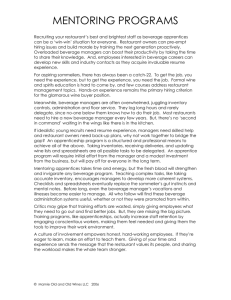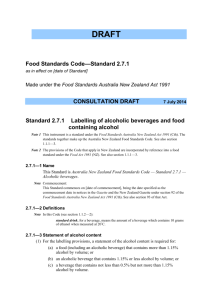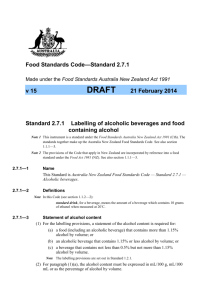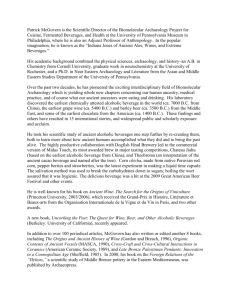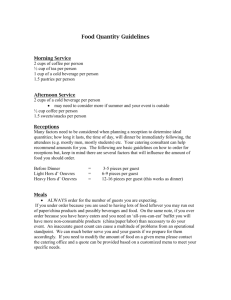Drink Promotions
advertisement
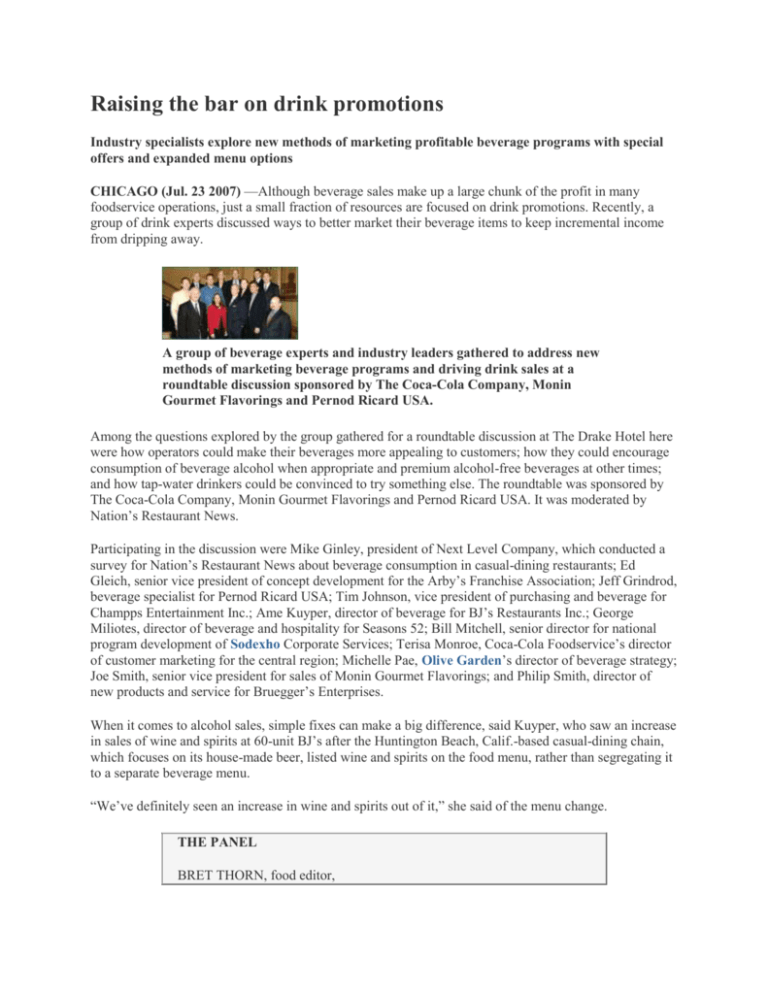
Raising the bar on drink promotions Industry specialists explore new methods of marketing profitable beverage programs with special offers and expanded menu options CHICAGO (Jul. 23 2007) —Although beverage sales make up a large chunk of the profit in many foodservice operations, just a small fraction of resources are focused on drink promotions. Recently, a group of drink experts discussed ways to better market their beverage items to keep incremental income from dripping away. A group of beverage experts and industry leaders gathered to address new methods of marketing beverage programs and driving drink sales at a roundtable discussion sponsored by The Coca-Cola Company, Monin Gourmet Flavorings and Pernod Ricard USA. Among the questions explored by the group gathered for a roundtable discussion at The Drake Hotel here were how operators could make their beverages more appealing to customers; how they could encourage consumption of beverage alcohol when appropriate and premium alcohol-free beverages at other times; and how tap-water drinkers could be convinced to try something else. The roundtable was sponsored by The Coca-Cola Company, Monin Gourmet Flavorings and Pernod Ricard USA. It was moderated by Nation’s Restaurant News. Participating in the discussion were Mike Ginley, president of Next Level Company, which conducted a survey for Nation’s Restaurant News about beverage consumption in casual-dining restaurants; Ed Gleich, senior vice president of concept development for the Arby’s Franchise Association; Jeff Grindrod, beverage specialist for Pernod Ricard USA; Tim Johnson, vice president of purchasing and beverage for Champps Entertainment Inc.; Ame Kuyper, director of beverage for BJ’s Restaurants Inc.; George Miliotes, director of beverage and hospitality for Seasons 52; Bill Mitchell, senior director for national program development of Sodexho Corporate Services; Terisa Monroe, Coca-Cola Foodservice’s director of customer marketing for the central region; Michelle Pae, Olive Garden’s director of beverage strategy; Joe Smith, senior vice president for sales of Monin Gourmet Flavorings; and Philip Smith, director of new products and service for Bruegger’s Enterprises. When it comes to alcohol sales, simple fixes can make a big difference, said Kuyper, who saw an increase in sales of wine and spirits at 60-unit BJ’s after the Huntington Beach, Calif.-based casual-dining chain, which focuses on its house-made beer, listed wine and spirits on the food menu, rather than segregating it to a separate beverage menu. “We’ve definitely seen an increase in wine and spirits out of it,” she said of the menu change. THE PANEL BRET THORN, food editor, Nation’s Restaurant News MIKE GINLEY, president, Next Level Company ED GLEICH, senior vice president of concept development, Arby’s Franchise Association JEFF GRINDROD, beverage specialist, Pernod Ricard USA TIM JOHNSON, vice president of purchasing and beverage, Champps Entertainment Inc. AME KUYPER, director of beverage, BJ’s Restaurant Inc. GEORGE MILIOTES, director of beverage and hospitality, Seasons 52 BILL MITCHELL, senior director of national program development, Sodexho Corporate Services TERISA MONROE, director of customer marketing for the central region, The Coca-Cola Company MICHELLE PAE, director of beverage strategy, Olive Garden JOE SMITH, senior vice president of sales, Monin Gourmet Flavorings PHILIP SMITH, director of new products and services, Bruegger’s Enterprises Inc. Johnson admitted that Littleton, Colo.-based Champps had done the reverse about 18 months earlier. “We went and produced a separate menu, and the big mistake was taking the six core beverage alcohol drinks off of the main menu and putting them into the specialty drink menu, and taking the wine list off of the main menu and having it be separate,” he said, resulting in a decrease in wine and spirits sales. The 63-unit casual-dining chain is now in the process of going back to the older format, he added. Joe Smith from Monin advocated table tents, pointing out that Orlando, Fla.-based Olive Garden, which is owned by Darden Restaurants and a Monin client, uses the tents to promote sangría. “We can track the sales, obviously, and we see a significant increase when that table tent is actually on the table,” he said. BRET THORN, Nation’s Restaurant News Pae, who is responsible for beverage alcohol sales at the 603-unit Olive Garden casualdining chain, said the table tents are used to show pictures of beer and cocktails paired with appetizers. All food has suggested wine pairings, she said, but the menu never has suggested pairings with nonalcoholic drinks. She added that they were considering using different table tents at lunch that would show pictures of alcohol-free drinks with specific dishes. Monroe, from Coca-Cola, suggested dovetailing promotions of alcoholic and nonalcoholic beverages. “So if [you’re promoting] a pomegranate martini or something like that, then you also have a nonalcoholic version of it that can be featured at the lunch daypart, or in the evening if the person is not going to have an alcoholic beverage,” she said. She said that would make it easier for servers to remember the promotions. Pae said 35 percent of Olive Garden’s guests would never order an alcoholic beverage, “but I also want to be able to have those people have as great an experience as people who are drinking the pomegranate margarita.” Mitchell, from Gaithersburg, Md.-based on-site feeder Sodexho, said a promotion that combined CocaCola and Monin products worked well because it gave customers out-of-the-ordinary options. The promotion, implemented last winter, was called “Daily Departures, Escape to the Exotics.” “It really created a nice change of pace and was a really good sales generator,” he said. In the summer, they add a little fruit purée to their lemonade. “We can sell that for about twice of what we can for the base lemonade, and they fly out the door in the summertime,” Mitchell said. “That’s what Red Robin does,” said Monroe of Coca-Cola, noting that the casual burger chain’s lemonade with strawberry purée sells for $4. Kuyper of BJ’s said that finding points of differentiation from competitors was important. BJ’s does that not only with its beers, she said, but also with its wines, of which they sell 19 types by the glass instead of the more typical seven or eight varieties made available in many casual-dining restaurants. But when it comes to nonalcoholic drinks, she said many restaurants overdo it. MIKE GINLEY, Next Level Company “I think one of the mistakes that restaurants make is they try to put too many nonalcoholic drinks,” she said, “and they all put the same stuff on. Everybody has a strawberry colada and a nonalcoholic one. You have to be unique. We have a homemade root beer that is our root beer, made from scratch on site in each building. You can’t go anywhere else to get that product.” She added that BJ’s was likely to add house-made cream soda and vanilla sodas to their drink mix. Smith of Monin, who pointed out that restaurants don’t want to cannibalize sales of one category for another, underscored the importance of targeting tap-water drinkers. “We want to look at ways of taking a nonprofit-gathering beverage and making it a profit-gathering beverage,” he said. Grindrod of Pernod pointed to what he saw as low-hanging fruit. He said that most guests, when seated at a casual restaurant, are simply asked if they want a drink, “but when it comes time to order an appetizer or an entrée, you’ll get four or five different fantastically described opportunities. And if you’re trying to sell a wine, a beer, a spirit and a nonalcoholic specialty drink, it should be treated just like your food,” he said. Reviewing some of the research conducted before the panel meeting, Grindrod observed that two-thirds of customers don’t know what they plan to drink when they enter a restaurant. Yet suggestive selling of drinks is relatively rare. ED GLEICH, Arby’s Franchise Association However, Kuyper pointed out the dangers of requiring servers to present an excessively long spiel to customers, especially return guests who don’t want to hear the same monologue every time they come into the restaurant. Johnson of Champps said the casual-dining segment continues to treat “beverage alcohol and nonalcoholic beverages as the ugly stepchild of the industry,” even though beverages are where much of the profit is made. “At Champps, 30 percent of our business is beverage alcohol, anywhere from 5 [percent] to 7 percent is nonalcoholic beverages,” he said, but that 37 percent of sales accounts for 42 percent to 45 percent of profit. He said the industry had yet to find the right balance between training servers to sell alcohol responsibly—something that has been inculcated into restaurant and bar service culture over the past 20 years as third-party liability regulations went into effect—and still encouraging them to sell it. In the process of teaching servers about the dangers of overconsumption, Johnson said that operators have given servers the impression that they didn’t want them to sell beverage alcohol. “We’re our own worst enemy in that respect,” he said. Kuyper of BJ’s pointed out that, given the high turnover in restaurants, especially among servers, effective training is a challenge. “How much information can you really get them to get in their brain and get straight in the one month or two months that they work for your company…when they’ve never drunk wine before in their entire life, or they don’t know the difference between a Rob Roy and a cosmopolitan?” she asked. JEFF GRINDROD, Pernod Ricard USA Ginley from Next Level, underscoring the importance of beverage sales in restaurants, said that if beverages account for 20 percent to 25 percent of a restaurant’s sales, they might account for around half of the restaurant’s profit but only get 10 percent to 15 percent of research, training and other resources. “I think the key to unlocking the beverage culture is to talk about profit, not just sales,” he said. Miliotes said that at high-end casual restaurants like Seasons 52, the seven-unit Darden Restaurants concept where he is responsible for beverages, the line is blurring between fine and casual dining, and the casual restaurants must respond with better training. TIM JOHNSON, Champps Entertainment, Inc “We get people that come in and have plenty of money to spend,” he said. “We have to learn to train our people every single day on what they’re selling. I think that’s how we expand beverage marketing. That’s the largest single opportunity there is out there.” Grindrod of Pernod Ricard agreed. Paraphrasing human resources specialist Jim Sullivan, he said that training people who then leave your company is not as bad as not training them and having them stay. “We always say that the guest experience can’t exceed the server experience,” Pae of Olive Garden said. “If they like what you’re promoting and what you have on your menu, they’re going to talk about it, and they’re going to engage the guests in that conversation.” Ginley, referring to the beverage survey his company conducted, pointed out that 60 percent of customers like to try new drinks every 90 days or so and recommended introducing drink specials every quarter. Pae said a drink promotion could work in the same way that limited-time food offerings do and serve the same purpose: It gives servers something newsy to talk about, and it gives customers a reason to stop by to see what’s new. Ginley said casual-dining chains in general were better at marketing than they were at training. AME KUYPER, BJ’s Restaurant Inc. “The menus and table tents are driving order influences far more than the server and bartenders,” he said. “I think casual dining, as a whole, does a great job merchandising and not a super job with server suggestion. In fact, we survey a lot of top chains, and you’d be surprised how it’s very generic: ‘What can I get you to drink?’ or ‘What will it be?’ ” Pae said that Olive Garden servers approach every table with a bottle of wine to offer a free sample. “We gave away 30,000 cases of wine last year,” she said. One result, among others, has been a doubling of wine sales over the past five years. Forty percent of guests who receive a free sample end up buying some wine, she said. “We spend $8 million a year on wine training, and that doesn’t come from suppliers,” she added. “That comes from us, because it’s important.” GEORGE MILIOTES, Seasons 52 However, 23 percent of Olive Garden’s guests still drink only tap water. Smith from Monin said that providing a nonalcoholic option that isn’t the usual stuff from fountain guns might encourage members of that 23-percent group to try something new. They might not be inspired by run-of-the-mill lemonade, but “how about pomegranate lemonade?” he suggested. “How about flavored iced tea? How about flavored Sprite? “You need to present options to people because it’s too easy for [customers who aren’t drinking alcohol] to say: ‘No thanks. I’ll just have water with lemon,’ ” he continued. “We’ve got to eliminate that. The way to do that, I think, is to present options to them.” Miliotes of Seasons 52 suggested that sampling beverages other than wine would likely work well. He said selling wine by the glass removed diners’ intimidation at ordering a whole bottle of wine, and it also made it easier to give guests tastes of wine because servers don’t have to open a bottle to do it. “If they don’t like [the wine], you’ve just gotten goodwill because you were a good guy that allowed them to try,” he said. “What keeps us from doing that with any other thing that’s liquid? Nothing except our laziness or our fear of losing money on it.” He added that restaurateurs also are hesitant to offer more wines by the glass for fear of losing it to spoilage. But the resulting increase in wine sales far outstrips the amount of wine that goes bad. Mitchell of Sodexho said he saw a place in the market for nonalcoholic drinks that were just as interesting and cool-looking as cocktails. BILL MITCHELL, Sodexho Corporate Services “I think it goes back to the glass,” Pae of Olive Garden said. “One thing we learned about a year and a half ago was the glass that we were serving our nonalcoholic drinks in felt very boring and unspecial. So people who weren’t drinking alcohol, for whatever reason, chose not to even drink because we were giving them an ugly glass when everybody [who’s drinking alcohol is] getting these fancy martini glasses. We changed our glasses to make it feel more special and more unique,” and that had a positive impact on sales, she said. Monroe of Coca-Cola said T.G.I. Friday’s tested nonalcoholic beverages by starting them on the kids’ menu. “They started their whole slushy program with their kids’ menu,” she said. She said Texas Dairy Queen also was launching new flavors in an attempt to follow Sonic’s model of offering a wide array of flavorings that can be added to soft drinks. But she observed that such programs require systemwide commitment. TERISA MONROE, The CocaCola Company “You make a conscious decision this is something you want to do, you get your system behind it and you can make a lot more progress,” she said. The topic of energy drinks, with and without vodka added to them, also came up. Johnson said Champps left it up to their individual restaurants’ directors of operations to decide whether to offer energy drink cocktails. “Of our 49 restaurants, 47 of them offer it and sell it on a regular basis,” he said. “Who are you selling them to, your employees?” Pae asked. “We didn’t sell one to a guest.” Mitchell said that, although energy drinks are thought of as appealing to people below working age, they are “becoming a huge category” at Sodexho. “It just keeps growing and growing and growing, and people are often replacing their coffee in the morning with a can of Rockstar or whatever,” he said. Gleich of Atlanta-based Arby’s, a system of more than 3,500 quick-service restaurants, said that although fast feeders needed to offer drinks with extremely broad appeal, “I think the days of having eight Pepsi or Coke valves are over. You’ve seen us expand our shakes. Last summer we did swirl shakes. We took a lot of the ideas you’ve seen in casual dining [such as] the mudslide and we put that in a nice clear cup. Very visual.” Other shakes that Arby’s has introduced include orange cream, chocolate peanut butter and strawberry banana, he said. Pae, pointing out that some QSRs were adding refrigerated cases to their units, asked Gleich if Arby’s was going to follow suit, and he said they were considering it. “We’re really trying to determine [how to sell] bottles to go,” he added, noting that between 55 percent and 65 percent of Arby’s business came from the drive-thru and those customers might like the same offerings available from the fountain served in bottles for the sake of convenience. “Or is it a play to expand your beverage variety?” he wondered, making energy drinks, vitamin waters, and other canned or bottled options available. The topic of pairing food with beverages other than wine or beer was discussed, and Pae said Olive Garden’s research found surprising results, such as that for their male customers, the No. 2 drink they were likely to have apart from a Bud Lite was the chain’s frozen tiramisu milk shake. MICHELLE PAE, Olive Garden “To them it’s part of the Italian experience,” she surmised. Johnson of Champps also said that particular milk shake was something they could get only at Olive Garden. Pae also observed that other indulgent drinks are selling well, such as the chocolate martini. Gleich of Arby’s pointed out that coffee has seen a resurgence, but it seems to be mostly among collegeage people, and “for them it is sweet, it is milk-based.” Philip Smith of Bruegger’s, a 260-unit bakery-cafe chain based in Burlington, Vt., said coffee sales are predicated on educating counter staff and customers about coffee culture. “We’ve created expertise around coffee [and associated] value-added profits” and gotten “great margins” from it, he said. Miliotes observed that popular wines these days also tend to be on the sweet side. “We sell cases of Riesling in [Seasons 52] every week,” he said. “We like sweet.” Bottled water is a rapidly growing part of retail-beverage sales, but Johnson and Kuyper said that very little bottled water was sold at Champps or BJ’s, respectively. “We sell a reasonable amount,” Gleich said of the Arby’s system. “But there is a price sensitivity.” Because when bottled water costs more than soda, customers won’t buy much of it, he noted. Mitchell said that water was the No. 1 selling beverage for Sodexho. JOE SMITH, Monin Gourmet Flavorings “Everything from half liters to 20-ounce, 24-ounce, and we’re really having good success, too, with one-liter bottles,” he said, noting that many of his customers take it back to their workstations. “Tap water is an enemy of ours, too,” he added. “We go to the extent of hiding it if we can.” Most of the panelists agreed that sales of beverages overall had dropped in recent months, while consumption of tap water was on the rise. Smith of Monin gave three reasons for that. “It’s cost, it’s health issues, and it’s lack of alternatives,” he said. Mitchell also said he was getting push-back from environmentalists who were opposed to wasting the plastic of bottled water when they could drink tap. When it comes to marketing programs, selling wine by the glass seemed to be the most consistently successful program. Pae said 75 percent of guests who order wine at Olive Garden order the one that is recommended with their particular dish. Ginley of Next Level said staff competition to sell the most of a particular product could also be effective. He pointed to the 60-day Chili’s Margarita Madness contest as an example. Every week, the winners get different prizes. “So, basically, a store manager is tracking sales and awarding small prizes—maybe movie passes, things like that—at the store level on a weekly basis,” he said. Then the top hundred or so general managers go on a trip with top management to Mexico, he added. In terms of hard alcohol, Grindrod of Pernod Ricard said sales growth continued to be in the superpremium category, with much of the growth coming from vodka, followed by tequila, Irish whiskey and flavored rum. Martini sales, or at least sales of cocktails in martini glasses, continue to rise, largely because of their image, Johnson of Champps said. “Somebody once came up and said, ‘Why are martinis doing so well?’ ” he PHILIP SMITH, recalled. “I said, ‘First of all, most of them aren’t what I would consider a martini, Bruegger’s but even the bald-headed fat guy from Denver looks good with this glass.’ ” He Enterprises, Inc. pretended to hold a martini glass as he spoke. Johnson noted that one of Champps’ most popular cocktails is the Chocolate Martini. Ginley said cocktails were especially popular among women in their 20s, and he expected their growth in consumption to continue. “It’s in the marketing, it’s in the movies,” Kuyper said. “Image is everything,” Johnson added. “It’s an accessory,” said Philip Smith, from Bruegger’s. And an accessory that will continue to bring high profits, the panelists agreed.
